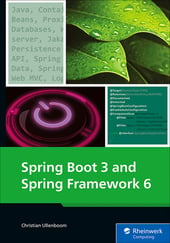Embarking on the journey of Java coding can be both exciting and daunting, especially for beginners. Frameworks like Spring Boot offer a friendly entry point into the world of Java development.
In this blog post, we will take a step-by-step approach to introduce coding beginners to the fundamentals of Spring Boot. From understanding its role in the Java ecosystem to creating a simple web application, this post aims to make your first foray into Spring Boot both accessible and enjoyable.
Understanding Spring Boot
Spring Boot is an open-source framework built on top of the Spring framework, designed to simplify the development of Java applications. It provides a convention-over-configuration approach, reducing the need for developers to deal with boilerplate code, configuration, and intricate setup.
Spring Boot streamlines the development process by offering a set of defaults and conventions. It eliminates much of the manual configuration required in traditional Spring applications, allowing developers to focus more on writing application code.
There are several key features of Spring Boot. The first is having an embedded server (examples include Tomcat and Jetty), reducing the complexity of deploying applications. Spring Boot also automatically configures components based on the dependencies in the project, reducing the need for manual configuration. Lastly, Spring Boot has a number of starters, or pre-configured templates for various types of applications, which simplifies the setup process.
Setting Up Your Development Environment
To get started with Spring Boot, you should make sure you have the latest version of the Java Development Kit installed on your machine. Spring Boot 3, for example, is compatible with JDK 17 and 19.
Next, you should choose an integrated development environment (IDE) that suits your preferences. Popular choices include IntelliJ IDEA, Eclipse, and Visual Studio Code. Install the Spring Boot plugin if applicable. This will make your programming easier.
After you’ve done this, visit Spring Initializr to bootstrap your Spring Boot project. Select your project settings, dependencies, and download the generated project structure as a zip file.
Learn more about setting up a Spring Boot project here.
Building Your First Spring Boot Project
Now you’re ready to build a Spring Boot project. To get started, unzip the downloaded Spring Initializr project and explore its structure. Key files include src/main/java, which holds your Java code, and src/main/resources, which contains configuration files.
Open the main application file (typically named DemoApplication.java) and examine the @SpringBootApplication annotation. This single annotation combines @Configuration, @EnableAutoConfiguration, and @ComponentScan.
Go ahead and add a simple "Hello, Spring Boot!" message in the main method and run the application. The code would look something like this:
@SpringBootApplication
public class DemoApplication {
public static void main(String[] args) {
SpringApplication.run(DemoApplication.class, args);
System.out.println("Hello, Spring Boot!");
}
}
Next, use your IDE to run the application. Spring Boot applications typically start a web server (e.g., Tomcat) on localhost:8080 by default.
If you open a web browser and navigate to http://localhost:8080, you should see your "Hello, Spring Boot!" message.
Exploring Spring Boot Concepts
Below we list a few important concepts to understand when using Spring Boot.
Controller
A controller is a Java class that handles incoming HTTP requests and provides responses to clients. It plays a crucial role in the Model-View-Controller (MVC) architecture, where it acts as the entry point for requests, delegates processing to appropriate components, and returns the appropriate response back to the client.
To create a simple controller to handle HTTP requests, use the code below. In the src/main/java directory, create a new package (e.g., com.example.demo.controllers) and a new class HelloController.java.
@RestController
public class HelloController {
@GetMapping("/hello")
public String sayHello() {
return "Hello from Spring Boot!";
}
}
Mapping URLs
The @GetMapping("/hello") annotation maps the sayHello method to the URL path "/hello". Run the application and visit http://localhost:8080/hello to see the new message.
Service and Dependency Injection
You can introduce a service class by creating a new package (com.example.demo.services) and a new class HelloService.java. You can also modify the HelloController to use the HelloService.
The @Service annotation indicates that HelloService is a Spring-managed service. The @Autowired annotation in the HelloController constructor injects the HelloService dependency.
Thymeleaf for HTML Templates
Thymeleaf is a modern server-side Java template engine for web and standalone environments. In the context of Spring Boot, Thymeleaf is commonly used as the view layer technology for generating dynamic HTML content in web applications.
To create a Thymleaf, create an HTML template in the src/main/resources/templates directory (e.g., hello.html).
You can also modify the HelloController to return the HTML template.
The @Controller annotation marks the class as a controller, and Model is a Spring interface used to pass data to the view.
Conclusion
Congratulations! You've taken your first steps into the world of Spring Boot development. This guide has introduced you to the basics, from setting up your development environment to creating a simple web application with controllers, services, and Thymeleaf templates.
Remember, coding is a journey of continuous learning and exploration. Stay curious, build, and enjoy the process of creating with Spring Boot! Happy coding!




Comments